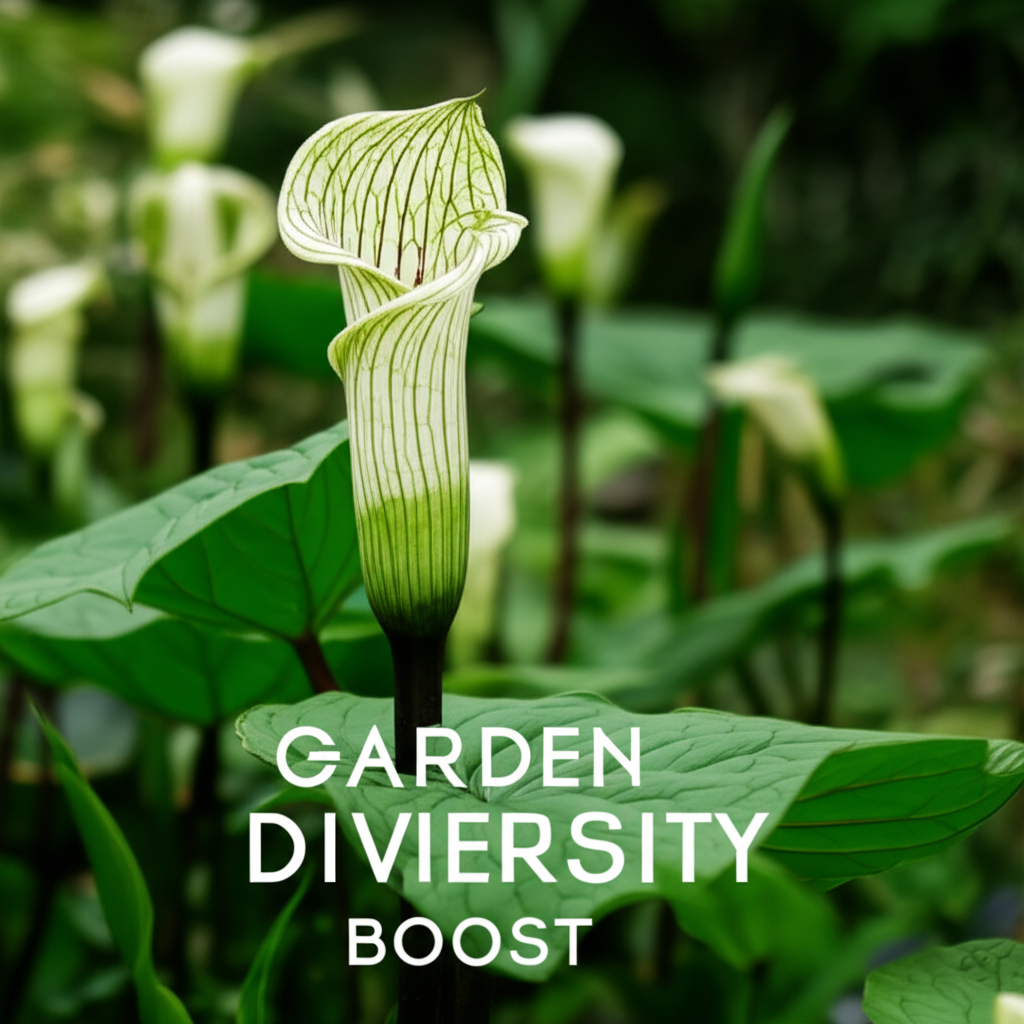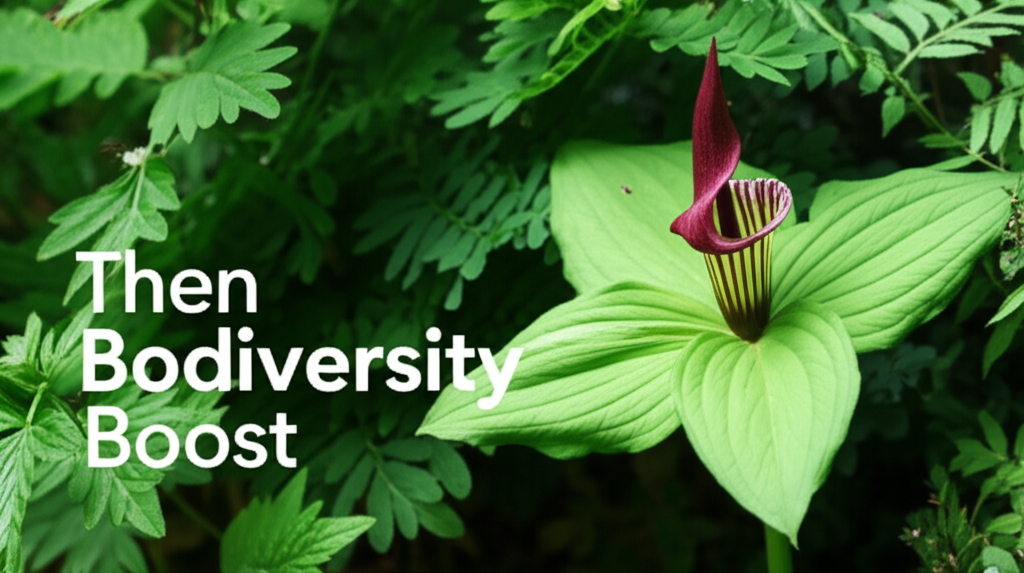The Allure of the Jack-in-the-Pulpit
Jack-in-the-Pulpit, scientifically known as Arisaema triphyllum, is a captivating native wildflower that graces woodlands and damp meadows across eastern North America. Its distinctive hooded spathe, resembling a preacher in a pulpit, and the accompanying spadix (the “jack”) make it a botanical marvel. Beyond its unique aesthetic, this woodland gem plays a surprisingly significant role in fostering a thriving, biodiverse garden ecosystem. This article delves into the multifaceted benefits of incorporating Jack-in-the-Pulpit into your landscape, exploring its ecological contributions, cultivation needs, and how it can serve as a cornerstone for a more vibrant and resilient garden.
Understanding the Jack-in-the-Pulpit’s Ecological Niche
Arisaema triphyllum is an herbaceous perennial that typically emerges in early spring, unfurling its characteristic trifold leaves. Its unique floral structure serves not only as a visual spectacle but also as an ingenious mechanism for pollination. Small insects, such as gnats and beetles, are lured into the spathe by scent and then trapped, where they encounter the male and female flowers. After facilitating pollination, they are eventually released. In late summer and fall, the plant produces attractive clusters of bright red berries, which are a crucial food source for various wildlife.
Boosting Biodiversity: The Jack-in-the-Pulpit’s Role

The presence of Jack-in-the-Pulpit in a garden setting offers a cascade of benefits, directly contributing to increased biodiversity on multiple levels.
Attracting Pollinators and Beneficial Insects
While not a primary nectar source for bees and butterflies in the same way as many cultivated flowers, Jack-in-the-Pulpit’s floral structure is specifically adapted to attract a unique set of pollinators. Fungus gnats, small beetles, and other minute invertebrates are drawn to the plant’s subtle scents and humid microclimate within the spathe. These insects, often overlooked in broader pollinator conversations, are essential for the reproductive success of Arisaema triphyllum and contribute to the overall health of the soil food web.
Furthermore, a healthy population of small insects can, in turn, support populations of insectivorous birds and amphibians. By providing habitat and a food source for these smaller creatures, Jack-in-the-Pulpit indirectly benefits a wider array of garden inhabitants.
Providing a Vital Food Source for Wildlife
The vibrant red berries of Jack-in-the-Pulpit are a highly prized food source for a variety of woodland creatures. Birds, including thrushes, robins, and jays, are known to feast on these berries, especially as autumn progresses and other food sources become scarcer. Small mammals, such as chipmunks and squirrels, also consume the berries.
This reliable food source is particularly important during migratory periods for birds and as a preparation for winter for mammals. By offering this readily available sustenance, gardeners can play an active role in supporting local wildlife populations and contributing to their survival.
Enhancing Soil Health and Structure
As a woodland native, Jack-in-the-Pulpit thrives in rich, moist, and well-drained soil. Its root system helps to break up compacted soil, improving aeration and drainage. As the plant decomposes annually, it contributes organic matter to the soil, enriching its nutrient content and supporting a healthy population of soil microorganisms.
A robust soil ecosystem is the foundation of any thriving garden. By encouraging the presence of plants like Jack-in-the-Pulpit, which are adapted to and contribute to healthy woodland soils, gardeners create a more resilient environment that can better support a wider range of plant and animal life.
Creating Habitat and Shelter
The broad leaves of the Jack-in-the-Pulpit provide a cool, shaded microhabitat that can be beneficial to various small creatures. It offers shelter from predators and the elements for insects, amphibians, and even small reptiles. The dense foliage can also help to retain moisture in the soil, creating a more favorable environment for beneficial soil organisms and other moisture-loving plants.
Supporting Native Plant Communities
When cultivated alongside other native wildflowers and plants, Jack-in-the-Pulpit contributes to the establishment and maintenance of a naturalistic planting scheme. This mimics the structure and diversity of native woodlands, creating a more harmonious and ecologically functional landscape. This is crucial for supporting native insect populations that have co-evolved with these specific plants.
Key Facts and Comparison
To better understand the advantages of Jack-in-the-Pulpit in a garden context, let’s compare it to some common garden plants and highlight its unique attributes.
| Feature | Jack-in-the-Pulpit (Arisaema triphyllum) | Common Garden Flower (e.g., Petunia) | Common Garden Vegetable (e.g., Tomato) |
|---|---|---|---|
| Native Status | Native to Eastern North America | Generally non-native hybrids | Native to South America |
| Pollinator Attraction | Specialist attractant for small insects; some berry consumption by birds/mammals. | Attracts bees, butterflies (nectar/pollen). | Attracts some bees (buzz pollination); fruit consumed by various animals. |
| Wildlife Food Source | Primary source of berries in fall for birds and small mammals. | Limited direct wildlife food source. | Fruits consumed by various animals. |
| Habitat Provision | Provides shelter for small invertebrates and amphibians; shade. | Minimal direct habitat provision. | Provides some cover; fruit consumed. |
| Soil Improvement | Contributes organic matter; improves soil structure. | Can compete with soil microbes; minimal soil improvement. | Can deplete soil nutrients; requires amendments. |
| Aesthetic Appeal | Unique, sculptural form; intriguing “flower.” | Bright, diverse colors; continuous bloom. | Foliage and fruit are ornamental; flowers are less showy. |
| Cultivation Needs | Shade to part-shade, moist, humus-rich soil. | Full sun to part shade, well-drained soil; often requires regular watering. | Full sun, fertile soil, consistent watering, support. |
Cultivating Jack-in-the-Pulpit for Maximum Impact
Successfully growing Jack-in-the-Pulpit requires understanding its natural habitat and replicating those conditions in your garden.
Site Selection: Mimicking the Woodland Floor
The ideal location for Jack-in-the-Pulpit is in a shaded to partially shaded area. It thrives under the canopy of deciduous trees or in north-facing borders where it receives dappled sunlight or morning sun only. Avoid hot, sunny locations, as these can scorch the leaves and dry out the soil too quickly.
Soil Preparation: The Key to Success
Jack-in-the-Pulpit demands rich, humusy, and consistently moist soil. Before planting, amend the soil with generous amounts of compost, leaf mold, or well-rotted manure. This will provide the necessary nutrients and improve the soil’s water-holding capacity. The soil should also be well-drained to prevent root rot. If your soil tends to be heavy clay, incorporate grit or sand to improve drainage.
Planting Techniques
Jack-in-the-Pulpit can be grown from seeds or tubers.
- From Tubers: This is the most common and quickest method. Plant the corms (which resemble small tubers) about 3-4 inches deep in the fall, or early spring before new growth emerges. The corms have a distinct top and bottom; plant the pointed end up. Ensure adequate spacing, typically 8-12 inches apart, to allow for mature growth.
- From Seeds: Sowing Jack-in-the-Pulpit seeds is a long-term project, as they can take several years to germinate and mature. Seeds require a period of cold stratification. Sow them in a gritty, well-drained mix in the fall and leave them outdoors to experience winter conditions. Germination will likely occur the following spring or even the spring after that.
Watering and Mulching
Consistent moisture is crucial, especially during the growing season. Water deeply and regularly, particularly during dry spells, ensuring the soil remains consistently damp but not waterlogged. Mulching around the base of the plant with a layer of organic material, such as shredded bark, pine needles, or compost, is highly beneficial. Mulch helps to retain soil moisture, suppress weeds, and regulate soil temperature, all of which are critical for the health of this woodland plant.
Companion Planting for Enhanced Ecosystems
To further amplify the biodiversity benefits, consider planting Jack-in-the-Pulpit alongside other native woodland plants that share similar growing conditions. This creates a more complete and functional habitat.
- Ferns: Many native fern species, such as Christmas fern (Polystichum acrostichoides) or maidenhair fern (Adiantum pedatum), thrive in similar shady, moist environments and complement the Jack-in-the-Pulpit aesthetically and ecologically.
- Wild Geranium (Geranium maculatum): Offers spring blooms and attractive foliage, sharing similar habitat preferences.
- Columbine (Aquilegia canadensis): Its delicate red and yellow flowers attract hummingbirds and bees, and it also prefers partial shade.
- Trillium species: These iconic woodland wildflowers are excellent companions, creating a quintessential woodland garden scene.
- Solomon’s Seal (Polygonatum species): Graceful arching stems and delicate white flowers add texture and beauty to the understory.
Seasonal Care and Maintenance
Jack-in-the-Pulpit is a deciduous plant, meaning its foliage will yellow and die back after setting seed in the late summer or fall. Do not be alarmed by this. Allow the foliage to naturally decompose, returning valuable nutrients to the soil. Leave the berry stalks intact over winter, as they can provide some aesthetic interest and continued food for birds. In spring, as new growth emerges, you can tidy up any dead foliage from the previous year.
Steps to Enhance Garden Biodiversity with Jack-in-the-Pulpit
Implementing Jack-in-the-Pulpit into your garden is a straightforward yet impactful way to boost ecological richness.
| Step | Description | Pros | Cons |
|---|---|---|---|
| 1. Site Assessment | Identify shaded, moist areas in your garden, ideally with rich soil. | Maximizes success for the plant; supports native ecosystem mimicry. | May require soil amendment if drainage or richness is poor. |
| 2. Soil Preparation | Amend soil with compost, leaf mold, or well-rotted manure. Ensure good drainage. | Provides essential nutrients and moisture retention. | Can be labor-intensive for large areas. |
| 3. Planting | Plant tubers in fall or early spring, 3-4 inches deep, 8-12 inches apart. | Establishes the plant for long-term growth and benefits. | Requires patience if starting from seed; tubers can be expensive. |
| 4. Watering & Mulching | Water regularly to keep soil consistently moist. Apply organic mulch. | Sustains the plant and creates a favorable microclimate for other organisms. | Requires consistent attention, especially during dry periods. |
| 5. Companion Planting | Integrate with other native shade-loving plants. | Creates a more complex habitat, supports a wider range of wildlife, enhanced aesthetic. | Requires careful selection of compatible species. |
| 6. Observation & Enjoyment | Observe the insects, birds, and other wildlife that visit your Jack-in-the-Pulpit. | Provides educational opportunities and deepens connection to nature. | None. |
Beyond the Aesthetic: The Long-Term Ecological Rewards
The decision to include Jack-in-the-Pulpit in your garden transcends mere horticultural interest. It is an investment in the health and resilience of your local ecosystem. By providing habitat, food, and contributing to soil vitality, you are actively participating in the conservation of native flora and fauna.
In an era where natural habitats are increasingly fragmented, suburban and urban gardens can serve as vital refuges for wildlife. Native plants like Arisaema triphyllum are the building blocks of these ecological havens. They support intricate food webs that are essential for the well-being of numerous species, from the smallest invertebrates to migratory birds.
Furthermore, a garden rich in biodiversity is a more resilient garden. A diverse planting scheme is less susceptible to widespread pest outbreaks or disease, as different species have varying levels of resistance. This natural balance reduces the need for chemical interventions, leading to a healthier environment for both humans and wildlife.
The beauty of Jack-in-the-Pulpit lies not only in its striking appearance but in its quiet, yet profound, ecological contributions. As it thrives, it weaves itself into the fabric of your garden, becoming a focal point for nature’s intricate dance. By cultivating this wild heart, you are nurturing a more vibrant, interconnected, and biodiverse world, one plant at a time.


